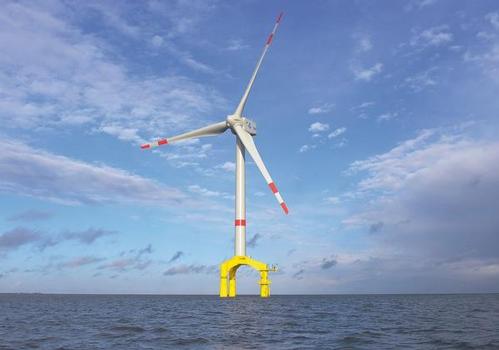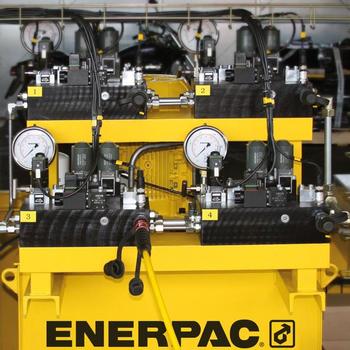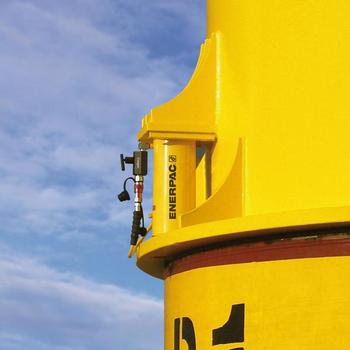Offshore wind turbines aligned on the open sea with the Synchronous Lifting System
Wind turbine manufacturer Bard Engineering GmbH has developed a unique concept for its wind turbines foundations. The mast stands on a support structure raised above the water on three legs. Enerpac’s Synchronous Lifting System was used to level this support structure accurately and within a short timeframe.
BARD Engineering was founded in 2003 with the aim of constructing wind turbines and offshore wind farms. Based on the philosophy that they did not want to depend on a wide range of suppliers, all parts plus everything needed for installation are developed, manufactured or assembled in their own factory. This also applies to "Wind Lift I”, the ship that was specially built for installing wind turbines on the open sea. The "BARD Offshore 1” wind farm is currently under construction in the North Sea, about 100 km north-west of the German island of Borkum. This wind farm consists of 80 BARD VM 5 MW wind turbines that will be equipped with what is known as a doubly fed induction generator (DFIG).
Unique foundation concept
The Bremen-based company has developed and patented a concept for wind turbine foundations: the BARD Tripile. The 90 m high wind turbine stands on three piles that are each 90 m long. Depending on the subsoil quality, these piles are driven 30 to 45 m into the seabed using a guide frame. Their position is accurately determined using a satellite-controlled navigation system and their height above the water is determined automatically to an accuracy of 3–4 cm. Above the water, the three piles are linked by the structure that supports the turbine mast. One of the unique things about the foundation is that the mast support structure and all connections are above the waterline. Masts are usually built off foundations that are below the surface, but BARD opted for having all installation activities performed above the water. There are numerous practical advantages: fewer divers needed, construction work less dependent on weather conditions, quicker and easier maintenance.
Levelling with 700 bar hydraulics
A level supporting structure is vital if the turbine mast is to be exactly vertical after installation. Enerpac’s hydraulic Synchronous Lifting System provided the solution for levelling the support structure. Connection flanges are not always exactly straight and manual correction of any flange deviations (to millimetre accuracy) turned out to be impossible. That is why BARD looked at other options for installing the 500 tonne supporting structure quickly and accurately – and chose synchronously controlled hydraulic cylinders. Three cylinders, each with a capacity of 100 tonnes and equally spaced around each pile, are required for installing the support structure. Each foundation therefore has nine cylinders with a total lifting capacity of 900 tonnes. The cylinders are connected to the computer of the Synchronous Lifting System on board "Wind Lift I”, which finally levels the support structure at the push of a button. To achieve this, the cylinders first lift the support structure by approx. 20 mm and then level it to an accuracy of 1 mm from that starting position. The installation process is controlled by the software using stroke sensors and an inclination meter. Once the support structure is level, it is locked in place together with the piles by a 5 m high concrete casing, with the concrete being poured into a void to create a 13 cm thick ring against the wall of both the support structure and the piles. Nothing is welded or bolted; the concrete casing handles all the stresses.
Standard cylinders
The cylinders remain in place until the concrete has set and can then be used for one of the other foundations. Meanwhile, BARD continues building the next foundation using other cylinders. BARD goal is to install and align the foundations quickly and so waiting three to four days until the concrete has set is not an option. A total of 450 standard 700 bar cylinders have been ordered for the first 50 wind turbines. BARD expects to use these cylinders twice. That may not seem very much, but it is not entirely clear as to how the cylinders will fare in such extreme weather conditions and saltwater. BARD has not chosen expensive special cylinders for the first test phase. In addition to cylinders, BARD Engineering has also invested in two control modules for the Synchronous Lifting System. Enerpac also trained the BARD employees who will be working with the Synchronous Lifting System. The results are excellent. It’s good to know that this hydraulic Synchronous Lifting System works completely automatically. Human errors when levelling manually, such as turning on the wrong valve, are impossible with this system.
Test turbine in Hooksiel
There is a test wind turbine in Hooksiel near Wilhelmshafen, 400 m off the coast. It was the first time that the patented BARD Tripile foundation, specially developed for offshore applications, had been used. This near-shore system is the same as the 80 wind turbines at the "BARD Offshore I” wind farm and has a nominal capacity of 5 MW. Depending on the tide, the water depth at this site varies between 2 and 8 m. The piles of the BARD Tripile were driven approx. 44 m into the ground – using the world’s largest piledriver! A 20 kV cable connects the wind turbine to the power grid.
The figures are impressive:
| weight of rotor: | 180 tonnes |
| weight of nacelle (machine housing): | 280 tonnes |
| weight of mast: | 2 sections weighing 130 and 160 tonnes |
| weight of foundation piles: | 400 tonnes |
| weight of support structure: | 500 tonnes |
| length of each pile: | 90 m |
| height of turbine mast: | 90 m |
| rotor diameter: | 122 m |
| capacity: | 5 MW |
| type of wind turbine: | BARD VM |
- About this
data sheet - Product-ID
6286 - Published on:
24/05/2013 - Last updated on:
30/01/2016



